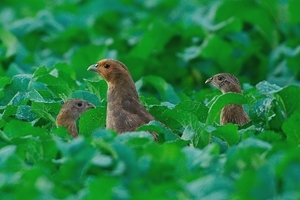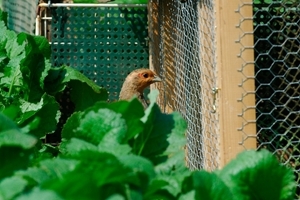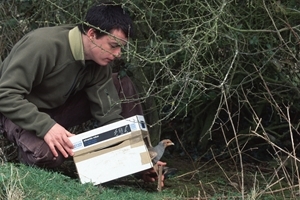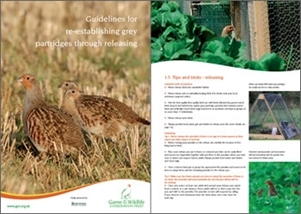General code of practice
 Never release birds into unsuitable habitat.
Never release birds into unsuitable habitat.- Never release sick or unhealthy-looking birds. If in doubt seek your local veterinary surgeon’s advice.
- Aim for best quality. Best quality birds are wild birds, followed by parent-reared birds (reared and hatched by captive grey partridge parents), then bantam-reared birds and artificially-reared birds (eggs hatched in an incubator and kept in groups of no more than 17 individuals).
- Never release tame birds.
- Always provide food, water, grit and shelter in release pens (more details on rearing).
Fostering
 Tip 1. Never release the juveniles if there is no sign of a foster parent as they stand very little chance of survival.
Tip 1. Never release the juveniles if there is no sign of a foster parent as they stand very little chance of survival.
- Before moving your juveniles to the release site, identify the location of free-living barren birds.
- Place your release pen (an A-frame or a framed pen that can be easily lifted and moved) together with just three to five juveniles, where you have seen or where you suspect barren adults. Always provide food, water and shelter and check daily.
- Once a barren bird, pair or group has approached the juveniles and seems to be keen to adopt them, add the remaining juveniles to the release pen.
Tip 2. Make sure the foster parents are keen to adopt the juveniles. If there is no bond, the juveniles will most probably die and all your efforts will be for nothing.
- Once you notice at least one adult bird around your release pen, watch from a vehicle at a safe distance. Keen adults will try to find a way into the pen and ‘talk’ to the juveniles. The juveniles in turn will respond by calling. If you observe such behaviour, leave the birds alone and come back the next day.
- If the adult birds are still present around the pen the next day, all the evidence suggests that they are ready for fostering.
Tip 3. Do not disturb the covey during release as this causes panic and the separation of covey members.
- Ideally, open the pen door with a cord from a distance of at least 20 metres. If that is not possible, open the door by hand and walk away from the pen without disturbing the birds.
- Watch the juveniles leaving the pen, or the adult(s) entering the pen, from at least 20 metres away and always inside a vehicle. Be patient as the birds may take several minutes to realise that the door is open.
- If you need to approach the opened pen, do it in a vehicle and not on foot.
Family groups (coveys)
Tip 1. The release pen should be placed near cover to reduce the chance of dispersal.
- Ideal cover would be, for example, a maize or kale game cover strip, which is not driven during the shooting season, next to a rape field or any other large holding crop. Other cover and holding crops may be suitable according to geographic location.
- The release pen should be easy to assemble and large enough to hold up to 19 birds. A standard redleg partridge release pen with a soft netted top is fine.
Tip 2. A covey should not be left in the release pen for more than one week. Within good habitat, the acclimatisation period seems to have little or no influence on dispersal.
- Keeping the birds in the pen for longer than really necessary increases the risk of injury, disease and predation.
- Coveys can be released in one go.
Tip 3. Do not disturb covey during release as this causes panic and the separation of covey members.
Translocated adults
Tip 1. Keep wild birds in captivity for as short a time as possible to reduce the chance of injury.
- Wild birds captured for translocation should be kept in a covered crate or in a cube-shaped cardboard box with air holes to minimise injury and so they can be released the next day. Wild birds kept in A-frames or any other wire-meshed pens are highly likely to injure themselves.
 Tip 2. Release translocated birds directly into the wild. Choose the location and day for release carefully to reduce separation between birds.
Tip 2. Release translocated birds directly into the wild. Choose the location and day for release carefully to reduce separation between birds.
- Immediate release (i.e. directly into the wild without being held in a pen) will be necessary in most cases, unless it is possible to build a pen large enough (approximately 3x8 metres with soft netted top per group) to minimise injury. Birds should be kept and released in the same groups (pairs or coveys) as those in which they were caught. They should preferably be released into dense cover (such as a well-vegetated hedge bottom or a game crop) on a calm day to reduce the risk of birds flying off in different directions.
Get your FREE guide from the GWCT Advisory team
Simply enter your email address below to download your essential free guide.
 What's inside your FREE guide
What's inside your FREE guide
✓ Background to releasing
✓ Guidelines for grey partridge re-establishment
✓ Measures needed for re-establishment
✓ Tips and tricks - releasing
✓ Husbandry practices
✓ Tips and tricks - rearing for release
✓ Summary of IUCN guidelines on re-introductions
*You may change your mind any time. For more information, see our Privacy Policy.